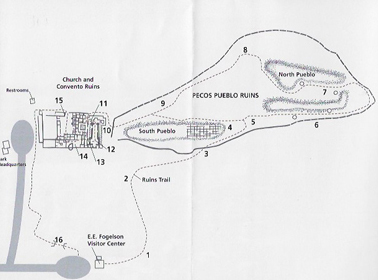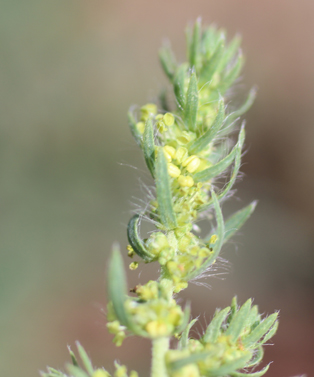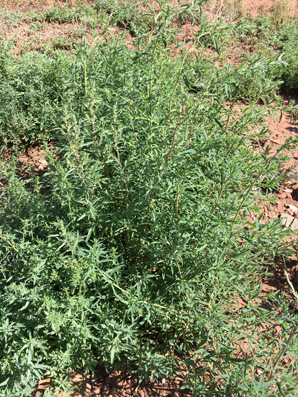
Location
Throughout the trail
Flowers first observed: 6/21/17
The Plant
The Flowers

Distribution
| Habitats | Roadsides, ditches and wasteland in western N. America[60]. |
| Range | Europe to Western N. America. |
Description
"Chenopodium is a ANNUAL growing to 0.3 m (1ft).
It is hardy to zone (UK) 6 and is not frost tender. It is in flower in September, and the seeds ripen in October. and are pollinated by Wind.Suitable for: light (sandy) and medium (loamy) soils. Suitable pH: acid, neutral and basic (alkaline) soils. It cannot grow in the shade. It prefers moist soil. The plant can tolerates strong winds but not maritime exposure." (Plants for a Future)
Ethnobotanical Uses
Food:
"Young leaves - cooked[105, 177]. A delicious taste, they are used as a vegetable[179]. A nutritional analysis is available[218]. Some caution is advised, see the notes above on toxicity. Seed - dried and ground into a powder then mixed with cereals when making bread, biscuits etc[61, 105, 177]. Very small and fiddly to use, it is also not a very reliable crop in Britain due to its late season of flowering[K]. On a zero moisture basis, the seed contains 20.4 - 27.5% protein, 8.8 - 16% fat and 3.4 - 9.4% ash[218]. In Japan the seeds are used a food garnish called tonburi." |
"Plants contain some saponins and should not be eaten in large quantities. Saponins are a toxin found in many of our daily foods such as many beans. They are usually present in quantities too small to be concerned about and are also very poorly absorbed by the body, tending to pass straight through without causing any problems. Saponins are much more toxic to some creatures, such as fish, and hunting tribes have traditionally put large quantities of them in streams, lakes etc in order to stupefy or kill the fish[K]." (Plants for a Future)
Medicine:
"Kochia scoparia has been used in Chinese and Korean folk medicine as treatment for skin diseases, diabetes, mellitus, rheumatoid arthritis, liver disorders, and jaundice (Kim et al., 2005; Choi et al., 2002). In Japan and China the fresh fruit is used as a food garnish on some dishes (Yoshikawa et al., 1997) and the seeds are ground into flour (Usher, 1974). In China, Russia, Bulgaria, Macedonia, Romania, and Italy kochia is planted for making brooms (Zimdahal, 1989; Shu, 2003; Nedelcheva et al., 2007; Friesen et al., 2009).
Kochia seeds contain an oviposition pheromone that can be added as an attractant for mosquito pesticides (Friesen et al., 2009; Whitney et al., 2004). The seeds of kochia have also been shown to contain other chemicals that could have beneficial human uses, such as compounds that could be use to treat ulcers, rheumatoid arthritis, and some human pathogenic bacteria (Friesen et al., 2009; Goyal and Gupta, 1988; Borrelli and Izzo, 2000)." (USDA)
Other Uses:
"Kochia seeds contain an oviposition pheromone that can be added as an attractant for mosquito pesticides (Friesen et al., 2009; Whitney et al., 2004). The seeds of kochia have also been shown to contain other chemicals that could have beneficial human uses, such as compounds that could be use to treat ulcers, rheumatoid arthritis, and some human pathogenic bacteria (Friesen et al., 2009; Goyal and Gupta, 1988; Borrelli and Izzo, 2000).
Kochia scoparia is grown as an ornamental due to its dense and conical shape as well as its bright red color in the fall (Undersander et al., 1990). (USDA)
"Kochia can be used for control of soil erosion. Undersander et al. (1990) indicated that it is able to survive in a variety of harsh soil conditions, including sandy and alkaline soils. Kochia scoparia is drought, salinity, and grasshopper tolerant and is able to grow in areas with very thin topsoil (Friesen et al., 2009). It is especially suited to arid to semi-arid regions (Friesen et al., 2009). It has the ability to germinate and grow at anytime during the growing season and will provide quick groundcover to protect the topsoil. For large inaccessible areas it can be sown using airplanes, making it ideal for revegetation after a fire.
Kochia has been shown to bioaccumulate cesium-137 (Lasat et al., 1997) and may be able to be used for remediation of hydrocarbon contaminated soil (Robson et al., 2004). (USDA)
Internet Links
